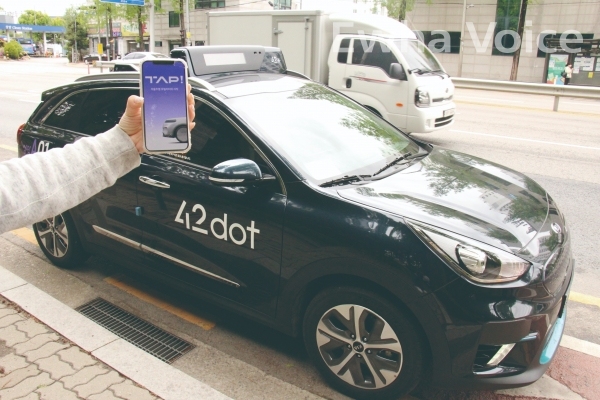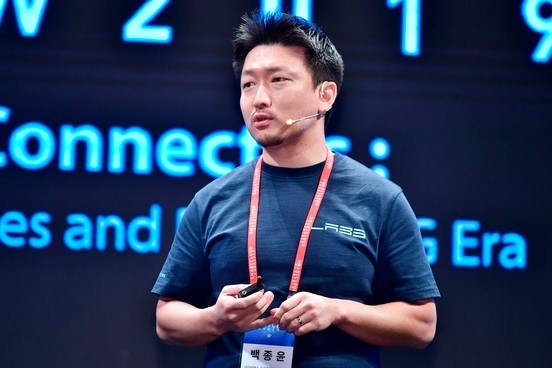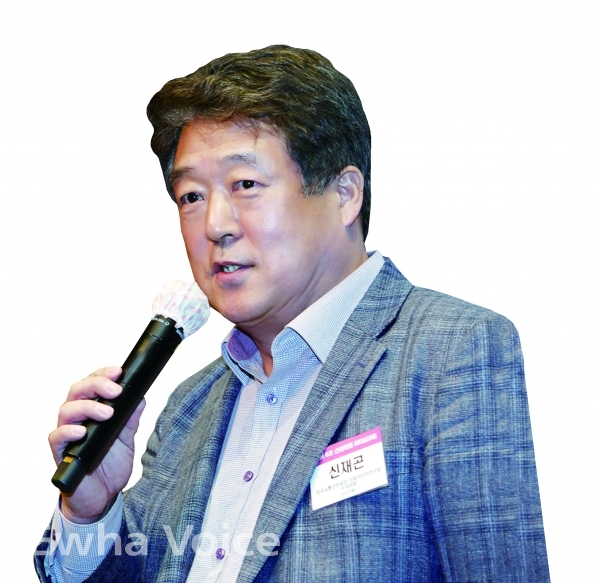By Choi Hye-jung, Han Jun-hee, Park So-hyun, Hyung Jung-won
Many car companies around the world have set 2022 as their goal for kick-starting level 3 autonomous cars. The Ministry of Land, Infrastructure, and Transport (MOLIT), referring to the scale established by Society of Automotive Engineers, has classified autonomous vehicles from 0 to 5 based on the amount of driver's engagement. According to MOLIT, level 3 autonomous vehicles allow drivers to take their eyes off the road, except when they receive Take-Over-Requests from the vehicles.
South Korea has also been investing and competing with other countries in the automotive industry for years. Now, self-driving cars are starting to roam the streets of Seoul on designated streets. On April 29, Ewha Voice took a ride in a driverless car developed by 42dot, an autonomous car service startup, for a first-hand experience and a real-time review. Additionally, several specialists shared their insights on driverless cars in terms of legislation, safety criteria, and research and development (R&D).
Hop on a ride with us on an autonomous car

Photo by Juanita Herrera Padilla
Since Feb. 10, the self-driving car service of 42dot has been available to the general public limited to a designated area in Sangam-dong. Anyone can get a taxi ride in an autonomous car just by booking a ride through an application called TAP!. Each ride costs two-thousand won, but the company offers free rides for all first-time users, which shall be very helpful for those looking for a simple experience.
Using the application was of no difficulty; it was simple and userfriendly. Once you are within the service area, you just pick a destination among the choices given in the application, book a ride, and the car will come pick you up.
Ewha Voice chose the route from exit eight of Digital Media City station all the way to the Seobu YMCA. It took approximately seven minutes for the car to arrive, and at first glance, it definitely looked different from regular cars on the streets. There was a camera-looking device stuck on the roof of the car and sensors on the sides.
Hopping in the back seat, in front of us was a monitor that showed a simple real-time graphic of the periphery of the vehicle, along with a line showing the path the vehicle was about to take, marking any other cars that came close to the line red.
A supervisor accompanied us in the driver's seat just in case of an emergency and since it is strictly required for a driver to be in control of the car when passing a school zone. He informed us when the vehicle was in autonomous mode and when he was at the wheel. He also mentioned that the car adhered to a conservative system where it always waits until the coast is completely clear before changing lanes or taking a turn, taking zero risks and prioritizing safety.
Overall, the ride was smooth, and it was quite difficult to tell whether it was the driver or the car in control.
Self-driving cars and changes in the judicial scene

Whenever a new technology is brought to life, change is inevitable. As a result of the growing interest in adapting driverless cars to the road, traffic laws are facing many changes. Ewha Voice consulted Oh Jeong-ik, a lawyer specializing in the application of artificial intelligence technology regulations and related adjustments to the legal system to learn more about the current driverless car regulations and the prospects regarding the implementation of this emerging technology.
The South Korean government has expressed its support towards the advancement of driverless vehicles by declaring the Act on Promotion and Support of the Commercialization of Self-driving Vehicles. Legislated April 4, 2019 and in force as of May 1, 2020, Oh stated that the law aims to improve people's living conditions and develop the national economy by promoting the commercialization of self-driving cars. He stated that the legislation has found a legal basis for establishing driving areas and safety standards, which are prerequisites for the commercialization of autonomous vehicles.
Oh pointed out the inadequacies of the existing regulations, explaining the importance of specified regulations on self-driving vehicles.
“Matters of who should bear civil or criminal responsibility for accidents and how to define driver concepts and qualifications must be discussed and improved on,” Oh said. “Currently, related laws are based only on partially self-driving cars that are partially controlled by humans and partially by the system. So, laws should be reorganized on the premise of completely selfdriving cars that run without human manipulation.”
One major concern Oh mentioned was the need for changes to licensing and liability. Since people do not intervene in driving in autonomous vehicles, the existing driver's license system should be completely changed. Once the self-driving cars' drivers are only passengers, targets of criminal punishment for traffic accidents should also be adjusted.
The most heated issue when it comes to autonomous cars is the question of who should be responsible for accidents.
“I cannot clarify which method is the best,” Oh said. “If fully autonomous driving is realized, it may not be possible to hold the existing driver in the car responsible for the accident as he will just be a passenger at that point. If the accident is due to an error in the autonomous driving system, the responsibility could fall to the manufacturer or program.”
On a hopeful note, Oh suggested we could consider converting some of the proceeds from vehicle sales into funds so that the liability costs can be resolved. While there seems to be a variety of possible approaches, since the existing legal system is not prepared, considerable social discussion should first take place.
When asked how advanced the laws related to self-driving cars in Korea are compared to those in foreign countries, Oh replied that Korea has been relatively slow in legal institutionalization and commercialization of partially selfdriving cars compared to Germany, the United States, and other European nations.
“In the case of the US, regulations are being completed so that fully autonomous vehicles can be operated,” he added. “It seems that Korea should also discuss issues pertaining to partially self-driving vehicles more actively and overhaul the related legal system.”
Oh expressed concerns about social issues that could emerge when self-driving cars are realized in everyday life. Job losses for people in driving industries, such as bus and taxi drivers, was one of the problems that came to his mind. Oh added that with the introduction of artificial intelligence technology, considerable occupational areas will inevitably be lost, giving rise to new social problems.
“Korea has achieved much of the technology needed for autonomous driving, so I do not think there is a big gap with other countries,” Oh said. “However, even if a fully autonomous vehicle has been technically developed, it will take a long time to be introduced to real-life driving environments unless research and preparation have been made on the improvement of the relevant legal system and social requirements. Therefore, I think the more active discussion needs to take place as soon as possible.”
The present and future of autonomous driving technology

Thanks to the vast development in technology, driverless cars do not seem like part of the distant future anymore. Many automobile companies are launching their own cars with autonomous options, behind which there is technology. Peck Jong-yoon, general manager of autonomous driving research at NAVER LABS, shared his thoughts on the research and development of the autonomous driving technology.
NAVER, owning one of South Korea's biggest portal sites, has worked on various online services so far. Its affiliated company NAVER LABS works on future technologies including robots, autonomous driving, augmented reality, and digital twin technology to materialize these services in the real world.
Peck, emphasizing the significance of many different emerging technologies used for autonomous driving, described the different projects NAVER LABS is working on.
“At NAVER LABS, we self-develop and study different software including high-definition mapping, localization, planning, control, perception, and more,” Peck said. “Ultimately, we aim to shape a new type of space on the road, where different products and services can be used without having to spend time driving.”
When asked about the current development stage of autonomous driving technology, Peck stated most obstacles as having already been overcome. He described the autonomous driving technology as showing huge progress these days related to recent developments in deep learning and machine learning.
Peck added that the remaining limitations were mainly in responding to unforeseen or rare circumstances. Although these situations may seem like the minority, he does not think they can be neglected as they are directly linked to safety issues. Peck also stated that the delay of commercialization could also be due to this limitation.
Peck emphasized the importance of reacting to these dangerous situations, along with the significance of general AI. For the autonomous vehicles to respond correctly to particular cases, common sense is required. For example, the AI embedded in and controlling the autonomous vehicle must know the difference between a plastic bag and a heavy rock in front of the car and command the device to react differently. This can be achieved through the development of general AI, which oversees a machine's general comprehension.
Peck also shared his thoughts on some emerging technologies in the autonomous driving field, stating data implementation and HD mapping as some of the most important technologies. He also emphasized the significance of detailed mapping, building a metaverse for the car, and evaluating different algorithms in implementing autonomous driving.
“Recently, the significance of data in machine learning has come to the fore,” Peck said. “It is important to construct a pipeline to merge data from the road and data from the virtual space.”
Peck described the effect of the generalization of autonomous vehicles by categorizing them into commercial and privately owned vehicles.
“Autonomous driving of private vehicles will provide driverless cars simply as a function,” Peck said. “But autonomous driving of commercial vehicles, including those used for transportation and distribution, will have a greater ripple effect in society.”
He also stated that the commercialization of autonomous vehicles should not only be seen as a technology to bring change but also the technology to stop change.
“Due to the population decrease, situations of car driver shortages will intensify, leading to the deterioration of products and services,” Peck said. “Someday, we will not be able to enjoy all the convenience we currently are obtaining due to these social problems. Delivery and mobility services using autonomous driving technology can provide cheaper, faster, and safer service, helping us maintain enriched lives.”
“In a larger extent, it can change the urban internal structure,” Peck said. “Roads may be used more efficiently, and the sizes of parking areas can be reduced, leading to a better urban environment for people.”
When asked for final comments and thoughts on autonomous driving technology, Peck described it as an inevitable future as well as a meaningful development, with a huge ripple effect that can even change the lifestyles of people. He also added that it can be seen as a field worth researching, as there are still many technical difficulties that must be overcome.
“I hope there are more people who gain interest in and realize the value of this field and jump into it to work on problems that yet remain to be solved,” Peck concluded.
Safety standards for users and further development of autonomous vehicles

South Korea is noted for its advanced safety standards. In 2020, it became the first country to announce safety standards for level 3 automated vehicles, laying the groundwork for their commercialization. Regarding the higher levels of automation, numerous researchers are seeking the proper assessment methods and criteria to ensure the safety of future vehicles.
Shin Jaekon, the chief of Automated Vehicle Research Office at Korea Automobile Testing & Research Institute (KATRI), is one of the renowned researchers in safety standards for autonomous vehicles. Shin devoted himself to autonomous vehicle research, working for KATRI since 1983.
Compared the level 3 driving automation to the level 2 automation, Shin thinks the most significant change is the matter of who to be responsible for accidents. Self-driving technologies in current use, such as Advanced Emergency Braking and Lane Keeping Assistance systems, are classified to level 2, since they still require the driver's constant monitoring. However, when the vehicle's automation reaches level 3, vehicles take responsibility for overall driving on designated roads. Human drivers only intervene when the vehicle sends a Take-Over-Request (TOR), a signal calling on a human driver to deal with an emergency.
“Level 3 vehicles need to verify their safety both while they are driving and when they hand the control to human drivers,” Shin said.
Ensuring safety during the TOR process is crucial in terms of the safety of level 3 vehicles, considering an accident caused by an automated Uber. The National Transportation Safety Board declared that the accident happened because the driver was visually distracted throughout the trip. However, Uber was also reprimanded for not considering safety, as the software of the vehicle did not properly identify a pedestrian or address the “operator's automation complacency.”
According to Shin, most tasks that R&D and legislation fields have encountered for the commercialization of level 3 autonomous vehicles have been completed already. Nevertheless, since any technical error caused by an autonomous vehicle can be fatal, the MOLIT and KATRI try to ensure vehicles' credibility and safety to nearly 100 percent. Shin expects level 3 autonomous vehicles to be up for sale by the end of 2022, as Hyundai Motor Groups aims to begin mass-production by that point.
To examine driverless vehicles before mass-production begins, KATRI operates a testbed, K-City. Shin stressed that different types of road environments are necessary to be constructed in a testbed. One is vicious environments such as inclement weather causing glare, and the other is geometric conditions such as interchanges and roundabouts. K-City is already equipped with incremental weather facilities and communication shadowing systems. Shin highlighted that KATRI will establish testbeds with slopes and interchanges to repeatedly evaluate the safety of level 4 or higher autonomous vehicles by 2024.
Furthermore, Shin and KATRI participated in establishing “Ethics Guidelines for Self-driving Vehicles,” assigning the roles of producers and users of autonomous vehicles. The ethics guidelines focused on the principle that autonomous vehicles should be designed and manufactured to place the utmost emphasis on the protection of human life. Manufacturers also need to take into account the people's right to privacy, which needs to be observed by users as well.
“In the future, it is expected that the ethics guidelines will serve as a standard for the judgment of an autonomous vehicle and an incentive system to induce ethical behaviors of manufacturers and users,” Shin said.
Shin assumed that Korean society would experience drastic changes with level 3 or higher autonomous vehicles. A shift in the transportation industry is inevitable, as the short-distance flight and railroad traffic services will be replaced by self-driving vehicles. He emphasized that the taxi business will go through changes with the advent of self-driving car-sharing services.
Although there has been progress in multiple fields to realize the increased use of autonomous vehicles, Shin anticipated that numerous issues that need to be dealt with will emerge when vehicles come into the market. Regardless of one's professions, students will face the moment their professions directly or indirectly related to autonomous vehicle issues. Issues in terms of law, ethics, and social acceptability are up to humanities and social sciences departments.
Shin emphasized the importance of the development in software technologies like artificial intelligence and deep learning that directly enhance the quality of automation.
“Software development is the key to the success of autonomous driving as it decides how much the vehicles, in a wider view the machine, can cover the human's activities,” Shin concluded. “I hope Ewha students think about why IT companies like Google and Apple have jumped into the self-driving car market.”

